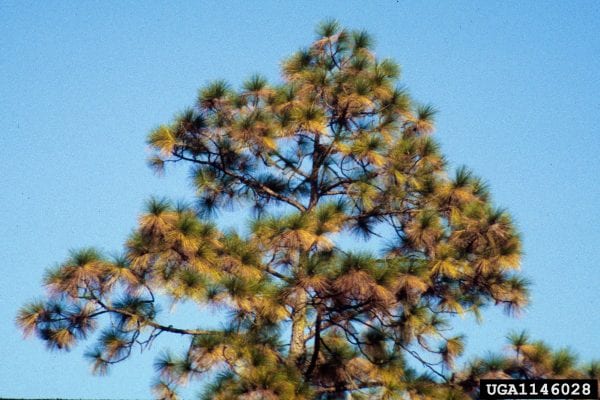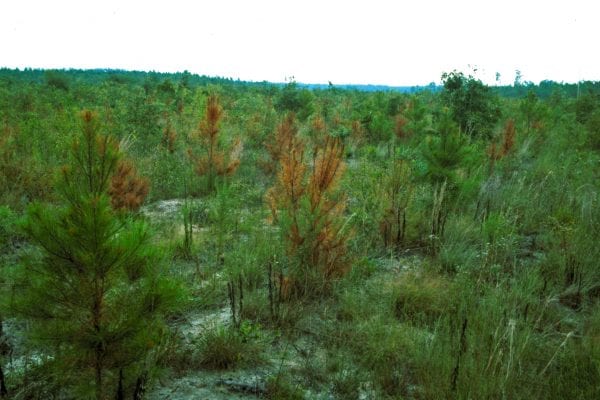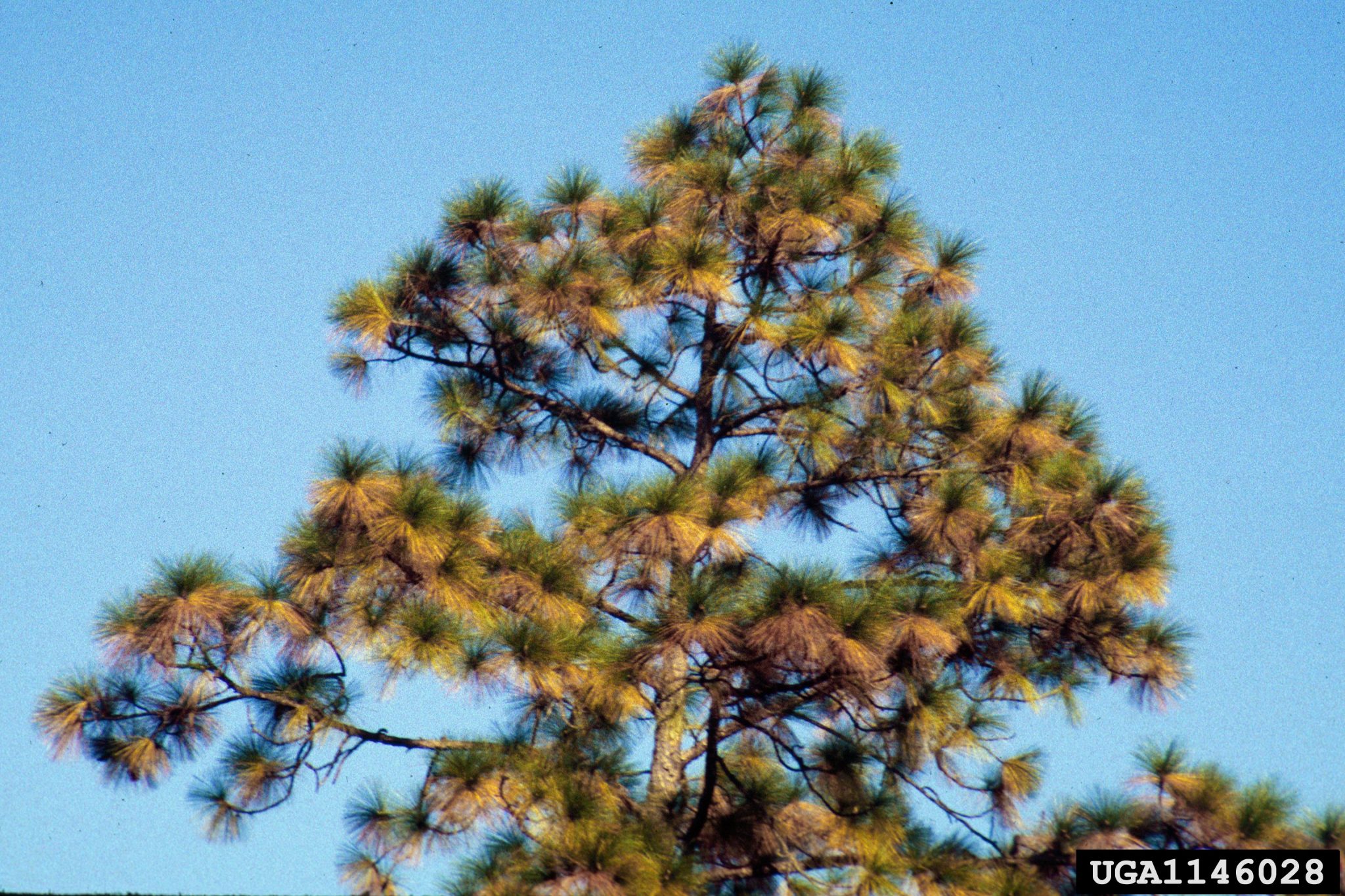Forestry

Learn forest management practices that can increase your land’s resiliency to drought and other stressors, improve growth rates, and sustain wildlife habitats.
Historically, drought has occurred across the southern United States and will continue to do so in the future. In years to come, little change in overall precipitation amounts is likely; however, the way it occurs is likely to change.
Larger, more intense precipitation events along with increased length of dry periods are projected for the Southeast. This coupled with projected increases in temperature can magnify the effects of drought across the region.
Forest landowners need to be aware of what drought is, how it can impact their forestland, and what they can do to minimize the risk.
What Is Drought?

Figure 1. A drought-stressed longleaf pine with yellowing and browning of older foliage. Notice that the last flush near the tips of shoots is still green. This is
a common response to prolonged drought conditions. (Photo credit: David J. Moorhead, University of Georgia, Bugwood.org)
Drought is defined as a shortage of precipitation over a period of time that causes impacts. These impacts can be economic, environmental, or social.
Economic impacts can include loss of monetary value or decreased revenue and increased costs. Environmental impacts can refer to loss of timber and wildlife habitat, or to stresses to and diseases in plants, wildlife, and ecosystems as a whole. Examples of social impacts could include loss of recreational value or opportunities, and health concerns or problems as a result of decreased water availability.
The National Drought Mitigation Center (NDMC) characterizes different types of drought as they relate to duration:
- Meteorological drought is specific to a region and based on average amounts of precipitation and duration of the dry period. These average conditions differ according to location (e.g., defined drought in Alabama is different than in Kansas). Precipitation deficits (reduced amounts, intensity, and timing) as well as changes in climate parameters (e.g., increased temperature, winds, lower relative humidity, and less cloud cover) can lead to drought conditions through reduced groundwater recharge and increased evaporation and transpiration. These characteristics and impacts are associated with early stages of drought or drought that is short-term in duration (weeks to months).
- Agricultural drought occurs when characteristics of meteorological drought cause impacts to vegetation and trees through soil water deficits, which cause increased stress, reduced growth, and ultimately reduced productivity (characteristics of both short- term and long-term drought).
- Hydrological drought occurs as the duration increases long-term (seasons or longer) and conditions worsen. Characteristics of hydrological drought impact water resources. Streams stop flowing and ponds and lakes regress or dry up completely. Indirect impacts include loss of wildlife habitat and significant tree mortality.
Broadly, these drought types can be used to distinguish short-term and long-term drought and their impacts.
Characteristics of short-term drought:
- Noticeable influence on understory vegetation
- Decreased soil moisture
- Enhanced wildfire risk
- Increased insect activity
- Impact on tree growth
- Possible tree mortality
- Prominent in seedlings and saplings
Characteristics of long-term drought:
- Directly affects the hydrological cycle
- Affects water resources
- Streams stop flowing.
- Groundwater availability disappears.
- Reservoirs or lakes regress or dry up completely.
- Causes significant loss of tree growth and tree mortality
What Causes Drought?
Drought can occur as a result of shifts in the climate patterns. It also can be influenced by increased temperatures over prolonged periods.
Shifts in climate patterns can create conditions that result in extended periods of limited precipitation. The exact cause is location specific. In the South, drought can be caused by the Bermuda high pressure system shifting westward during the summer and/or the La Niña phase of El Niño/southern oscillation, which develops during the winter.
Drought is also influenced by increased temperature. If temperatures increase, drought can occur more often and at a faster rate as evaporation and transpiration increase.
The Bermuda high pressure system is a subtropical area of high pressure located in the North Atlantic Ocean near Bermuda. Pressure causes the system to shift east or west.
If the system shifts to the east, the winds will come from the southwest, pushing moisture from the Gulf Coast and Atlantic Ocean across the southern United States. If it shifts westward, it positions itself over the western Gulf region. The flow of moist winds and precipitation misses the southern United States, influencing summer drought conditions from lack of precipitation.
The El Niño/southern oscillation is the change, either warming or cooling, of sea surface temperatures in the Pacific Ocean joined with changes in air pressure. A slight change in sea surface temperatures plus a change in air pressure causes one of the following to occur:
- La Niña
- El Niño
- Neutral phase
La Niña occurs as a result sea surface temperatures becoming cooler. This causes jet streams to push moisture to the north, causing warmer and drier winters across the South as a result of decreased precipitation. If El Niño occurs, the South will experience cooler, wetter winters. If conditions remain steady, a neutral phase of average temperatures and precipitation can be expected across the South.
Forecast of the El Niño/southern oscillation can provide insight to forest managers and landowners on what to expect in terms of wetter or drier conditions for the upcoming winter planting season.
How Does Drought Affect Trees?

Figure 2. Two-year-old seedlings dying on an upland site that was bedded. During the first growing season the site received above-average rainfall, and the roots stayed in the upper surface of the bed. In the second growing season a drought occurred early in the spring, and seedlings began to die as the beds dried out. (Photo credit: David J. Moorhead, University of Georgia, Bugwood.org)
Drought affects trees through the reduction of soil moisture, which causes water stress. During recent years, drought has been linked to widespread tree mortality events.
During drought, trees will limit water loss through the leaves by closing or regulating stomata (pores found in the leaves that facilitate the exchange of carbon dioxide (CO2) into the leaf and water loss from the leaf). This is one of the earliest tree responses to decreased water availability. Doing this also causes reductions in net photosynthesis and subsequently growth.
During longer or more intense droughts, trees may drop leaves. Trees with a greater quantity of leaves typically have greater total transpiration than do trees with a smaller quantity. Transpiration is when water is moved through the tree or plant from the roots and released into the atmosphere. Essentially, this is similar to sweating. Failure to reduce transpiration (water loss) rates during drought can harm trees; they can be injured from dehydration or possibly die.
Drought weakens trees, causing them to be more susceptible to disease and insect attacks. Effects of drought could linger well beyond the end of defined drought conditions. This depends on the severity of the injury sustained by the tree and its ability to recover before it is impacted by indirect stressors such as disease or insect attacks.
How Can Drought Affect Forests?
- Loss of young seedlings and saplings and old trees–Both young seedlings and saplings and old trees may be vulnerable to drought because of the combined effect of other stressors. For example, newly planted seedlings are not acclimated to the site and do not have well-developed or extensive root systems.
- Reduced growth, loss of vigor, and decreased resistance of trees–Trees respond to water stress by limiting or preventing water loss through shrinking or closing stomata in their leaves and/or by reducing leaf area. In turn, photosynthesis, carbon gain, and productivity are reduced. Trees are weakened and resistance to disease and insects decreases.
- Enhanced wildfire risk–Characteristics of drought include dry soils, dry plant and litter material (fuel), lower humidity, and higher temperatures, which are prime conditions for wildfire. Depending on the severity of fire, widespread mortality could result.
- Impacted wildlife–Drought directly limits water supply (rivers, streams, ponds) and indirectly limits available food sources through its impacts on vegetation and trees. Extreme drought can lead to lower production rates, cause animals to relocate, and cause mortality.
What Can Be Done about Drought?
- Manage your forest properly and actively. Proper timing of forest management activities, such as thinning and prescribed fire, can increase the availability of nutrients through reduced competition. This can lead to increased carbohydrate reserves that can strengthen tree resistance to drought and other stressors.
- Monitor your forest. Look for signs of drought stress. In southern pines look for early needle fall, yellow or brown needles, and evidence of pine bark beetles (rosin tubes, sawdust around base of trees, galleries under bark). In deciduous trees look for wilted or curled leaves and early color change and leaf fall. Areas such as overstocked stands and sandy, rocky, or shallow soils are more sensitive to drought and should be monitored frequently.
- Be proactive. Planning and management are key! Landowners can increase resistance by favoring resilient management practices that reduce competition for water during dry spells and prolonged drought. This includes thinning to maintain appropriate stocking levels, reducing understory competition, planting the right species for the site, and improving available nutrients through fertilization. It is important to conduct such management activities prior to drought. There is very little that can be done once drought conditions occur.
Conclusion
Drought impacts forest health and productivity. Drought can have negative economic, environmental, and social consequences. Impacts can result in economic loss to landowners and indirect impacts to society and the regional economy. Landowners and managers can minimize risk and damage with sound management practices applied in a timely fashion. Good forest management can increase resiliency to drought and other stressors, improve growth rates, and improve wildlife habitat.
Additional Resources for Drought Monitoring and Education
- National Integrated Drought Information System
- www.drought.gov
- National Drought Mitigation Center
- www.drought.unl.edu
- Pine Integrated Network: Education, Mitigation, and Adaptation Project (PINEMAP)
- www.pinemap.org
- United States Forest Service
- www.fs.usda.gov/alabama/
- Alabama Forestry Commission
- www.forestry.alabama.gov/
- Alabama Burn Restrictions
- www.forestry.alabama.gov/Pages/Fire/BurnRestrictions.aspx
- Alabama Burn Permits
- www.forestry.alabama.gov/Pages/Fire/Burn_Permits.aspx
 Adam Maggard, Extension Specialist, Assistant Professor; Becky Barlow, Extension Specialist, Professor; and John Kush, Research Fellow, all with Forestry, Wildlife & Natural Resources at Auburn University
Adam Maggard, Extension Specialist, Assistant Professor; Becky Barlow, Extension Specialist, Professor; and John Kush, Research Fellow, all with Forestry, Wildlife & Natural Resources at Auburn University
Reviewed May 2022, Drought and Forests: Information for Landowners, FOR-2071

